Join getAbstract to access the summary!

Join getAbstract to access the summary!
Don Tapscott and David Ticoll
The Naked Corporation
How the Age of Transparency Will Revolutionize Business
Free Press, 2003
What's inside?
In the age of Internet, the hidden corporation is over. Prepare yourself for the world of transparency.
Recommendation
Authors Don Tapscott and David Ticoll examine the managerial implications of the age of transparency. Now that the Internet has enabled employees, suppliers, consumers, gadflies, critics and casual lookers to get and swap previously confidential information about companies, the business environment will never be its old self again. Companies have no confidentiality, no privacy and no way to dodge the truth. Those with nowhere to hide must get accustomed to life in the open. It’s not so bad. But to prosper in this wide-open world, managers need to understand that the new way of life has different demands than the old one. Although many of this book’s recommendations have become fairly well known, getAbstract.com finds plenty of insights that remain fresh and worth reading.
Summary
About the Authors
Don Tapscott and David Ticoll are longtime collaborators, and the authors of Digital Capital and Blueprint to the Digital Economy. They have written for such publications as The Wall Street Journal, The Financial Times and Forbes.









Comment on this summary